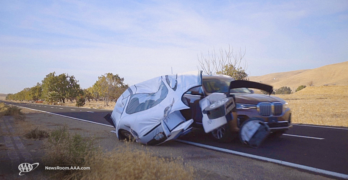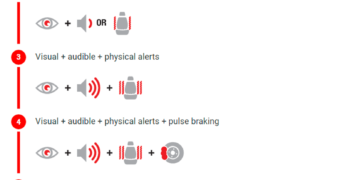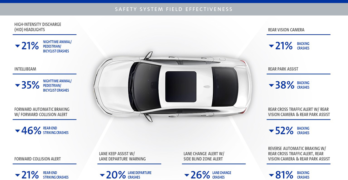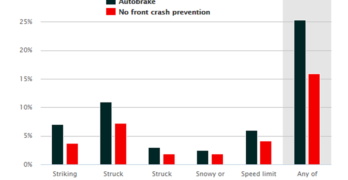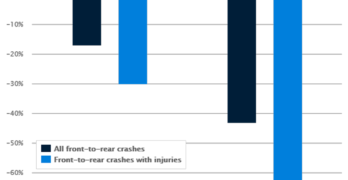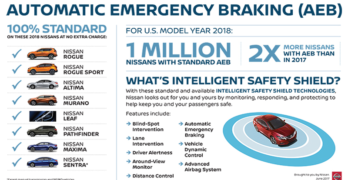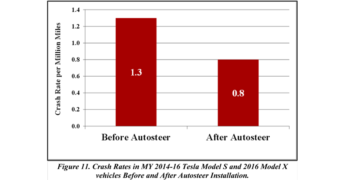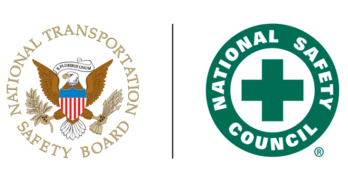AAA automotive researchers found that over the course of 4,000 miles of real-world driving, vehicles equipped with active driving assistance systems experienced some type of issue every 8 miles, on average. Researchers noted instances of trouble with the systems keeping the vehicles tested in their lane and coming too close to other vehicles or guardrails. […]
IIHS Issues Safety Recommendation for Vehicle Manufacturers to Keep Drivers with Automated Systems Focused on the Road
The Insurance Institute for Highway Safety has issued a set of research-based safety recommendations on the design of partially automated driving systems. The guidelines emphasize how to keep drivers focused on the road even as the vehicle does more of the work. According to IIHS, today’s partially automated systems still need the driver to be […]
General Motors and University of Michigan Detail Automated Safety Features Crash Prevention Performance
Analysis of accident reports in 10 states show significant reduction in collisions on vehicles with installed GM safety tech. General Motors and the University of Michigan Transportation Research Institute (UMTRI) released details of a study of the performance of collision avoidance technology on GM’s 2013-2017 product line. The results show that several of these features […]
IIHS Reports Autobraking Systems Reduce Accidents But Could Be Improved
In the latest edition of the Insurance Institute for Highway Safety (IIHS) Status Report, the organization reports on the results of a new study into the performance of auto braking systems designed to reduce collisions. According to the report, when it comes to preventing typical front-to-rear crashes, automatic emergency braking is a proven winner. But, […]
IIHS Finds GM Front Crash Prevention with Autobrake Cuts Collisions Over 40%
An Insurance Institute for Highway Safety (IIHS) study of General Motors vehicles with optional front crash prevention systems adds to the evidence that forward collision warning and automatic emergency braking prevent crashes. GM vehicles with autobrake and forward collision warning had 43 percent fewer police-reported front-to-rear crashes of all severities and 64 percent fewer front-to-rear […]
Nissan to Offer standard Automatic Emergency Braking on One Million U.S. vehicles in MY2018
More than doubles the number of AEB-equipped Nissan vehicles versus 2017 model year. Nissan announced that it is making Automatic Emergency Braking (AEB) standard on a projected one million vehicles sold in the United States for model year 2018, including seven of the company’s most popular models – Rogue/Rogue Sport, Altima, Murano, LEAF, Pathfinder, Maxima […]
NHTSA Closes Investigation into Tesla AutoPilot Crash
Office of Defect investigation finds no safety-related defect trends. Data shows 40 percent reduction in crash rates for Tesla vehicles after introduction of autosteer. The U.S. Department of Transportation’s National Highway Traffic Safety Administration’s (NHTSA) Office of Defect Investigation (ODI) yesterday released a report and closed its investigation into 2014-2016 Tesla Model S and X […]
National Transportation Safety Board, National Safety Council Plan Expert Panel on Technology’s Role in Eliminating Crashes
Transportation safety leaders, including vehicle manufacturers, insurers and regulators to discuss the future and potential of driver assistance technologies On October 27, the National Transportation Safety Board (NTSB) and the National Safety Council (NSC) have scheduled to an expert panel of government officials, car manufacturers, researchers, automobile media groups, industry associations, and safety advocates to discuss driver […]
Tesla Upgrading AutoPilot to Rely More on Radar
In a blog post yesterday, Tesla Motors announced it will be releasing an upgrade to its Autopilot software. According to Tesla, version 8 of its software will use more advanced signal processing of its onboard radar. According to the post, “The radar was added to all Tesla vehicles in October 2014 as part of the […]
AAA Tests Show Automatic Emergency Braking Systems Vary Significantly
Research highlights difference between systems designed to prevent crashes versus those designed to just lessen the severity of a crash. New test results from AAA reveal that automatic emergency braking systems, the safety technology that will soon be standard equipment on 99 percent of vehicles, vary widely in design and performance. All the systems tested […]
